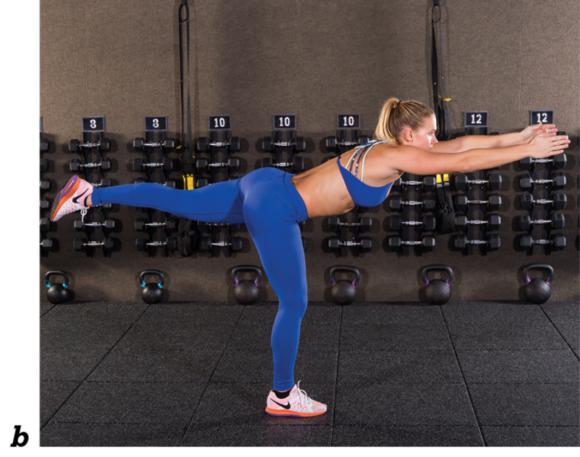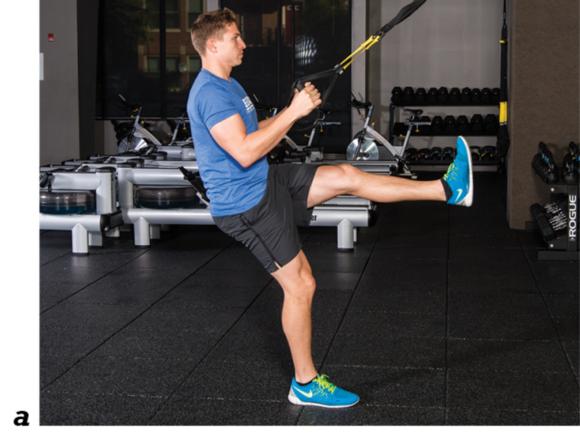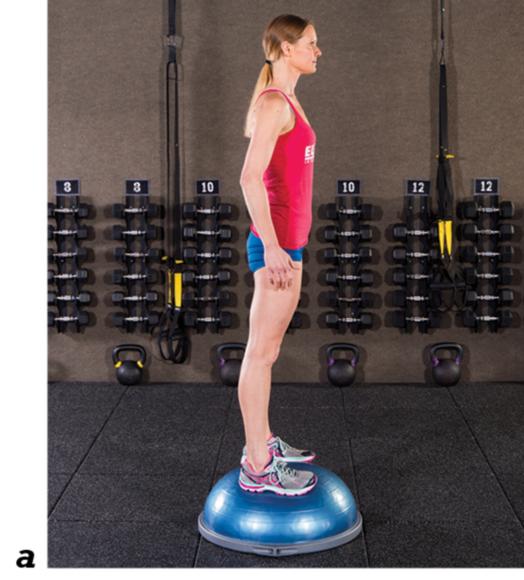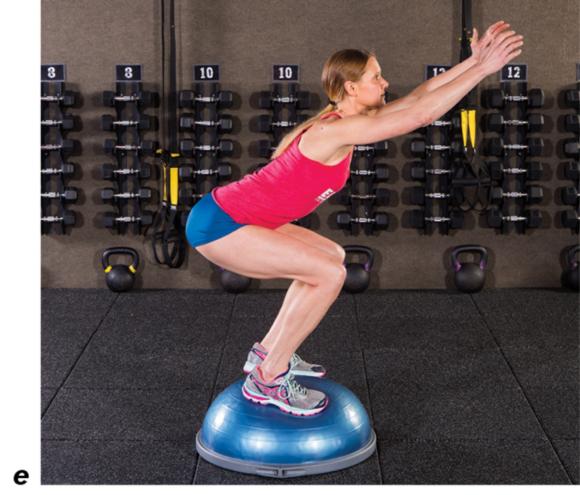Balance and Core Exercises
This is an excerpt from Essentials of Obstacle Race Training, The by David Magida,Melissa Rodriguez.
The following balance and core exercises will help you develop obstacle-specific balance and core stability for crawling through tunnels or low barriers (barbed wire, netted rope, wood planks) and walking over narrow beams as well as slippery and other unsteady surfaces.
Single-Leg Balance with Reach
Primary Muscles Worked
Hamstrings, glutes, calves, and back
Start
Stand tall with abdominals engaged and feet hip-width apart (see figure a).
Move
- Balance on your right leg as you lean and reach forward (slightly out and down) with both arms (see figure b).
- Simultaneously lift and extend your left leg behind you.
- Hold and balance for a moment.
- Return to start and repeat on opposite side.
Variation: Single-Leg Deadlift
For the move segment, reach toward your toes. This will further challenge your balance and stretch out the hamstrings.
Safety Tip
Keep your abdominals engaged and back strong during this exercise (for both the reach and progression deadlift).
Training Tip
The single-leg balance with reach and single-leg deadlift are both good warm-up and body preparation exercises for lunges and other leg work.


Single-Leg Squat
Primary Muscles Worked
Hamstrings, glutes, quads, and calves
Start
- Stand tall with abdominals engaged and feet hip-width apart. This exercise can be performed as a bodyweight exercise or with the use of dumbbells or a suspension device.
- Balance so that you are standing on your right leg (see figure a).
Move
- Bend the right knee and hips as you lower your glutes toward the floor (see figure b).
- Keep your heels on the floor and back strong throughout the move.
- Return to start and repeat single-leg squats with your right leg for the recommended number of reps.
- Switch legs to complete a set.
Safety Tips
- Keep your abdominals engaged and back strong during this exercise.
- Try to push through the midfoot and heel of the foot that's balanced on the floor as you get into a squat and return to stand.
Training Tip
The single-leg squat is another good warm-up and body preparation exercise for leg work and running.


Squat on a Balance Mat
Primary Muscles Worked
Hamstrings, glutes, calves, quads, and hip flexors
Equipment Needed
Balance mat, pillow, BOSU, or similar unsteady surface
Start
Stand tall with abdominals engaged and feet hip-width apart on a balance mat, pillow, or similar unsteady surface (see figure a).
Move
- Get into a squat while keeping your balance (see figure b).
- Bend at the hip and lower the glutes toward the floor.
- Return to start and do recommended number of reps.
Training Tip
To improve your balance, you can try other standing exercises on a balance mat or other unsteady surface.


Plank
Primary Muscles Worked
Abdominals, obliques, shoulders, and hips; with progression: hip flexors and extensors, quadriceps, adductors, and abductors
Equipment Needed
Mat (optional)
Start
- Get into a bent-elbow plank with your forearms and toes on the floor or mat (see figure).
- Engage your abdominal and gluteal muscles to hold your weight.
Move
Hold the plank for 30 seconds.
Variation: Plank With Knee Tuck
- For the move segment, bend and rotate your right knee out and tuck your right knee in toward your right elbow.
- Return to start and alternate legs for recommended number of reps.
Safety Tips
- Be mindful of your form, especially with the progression knee tucks. As you get tired, your hips may drop or rise.
- Keep your back straight, core engaged (squeeze the abdominal and gluteal muscles), and pelvis tucked under in order to keep your hips squared to the floor.

Learn more about The Essentials of Obstacle Race Training.
More Excerpts From Essentials of Obstacle Race Training, TheSHOP

Get the latest insights with regular newsletters, plus periodic product information and special insider offers.
JOIN NOW


